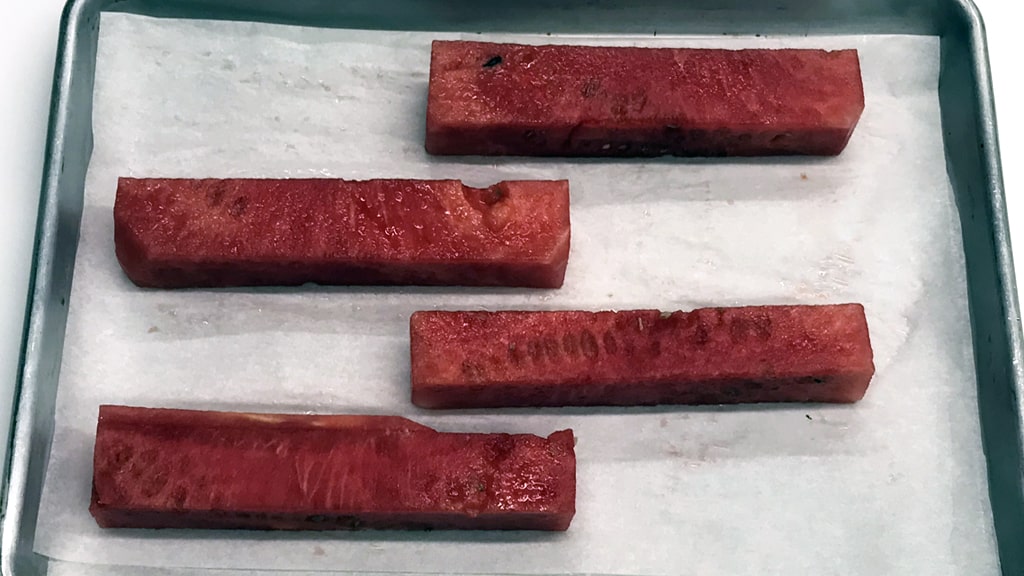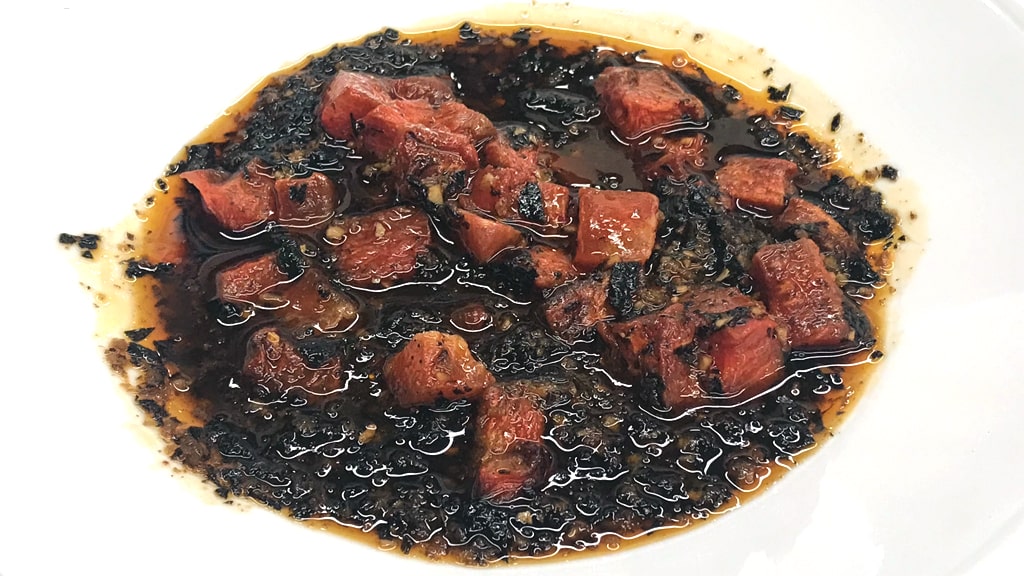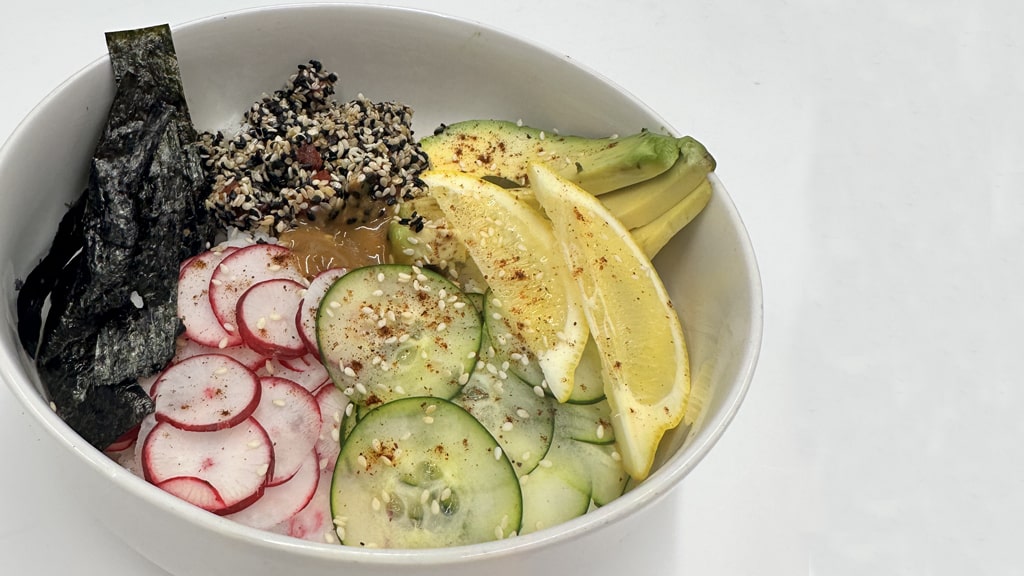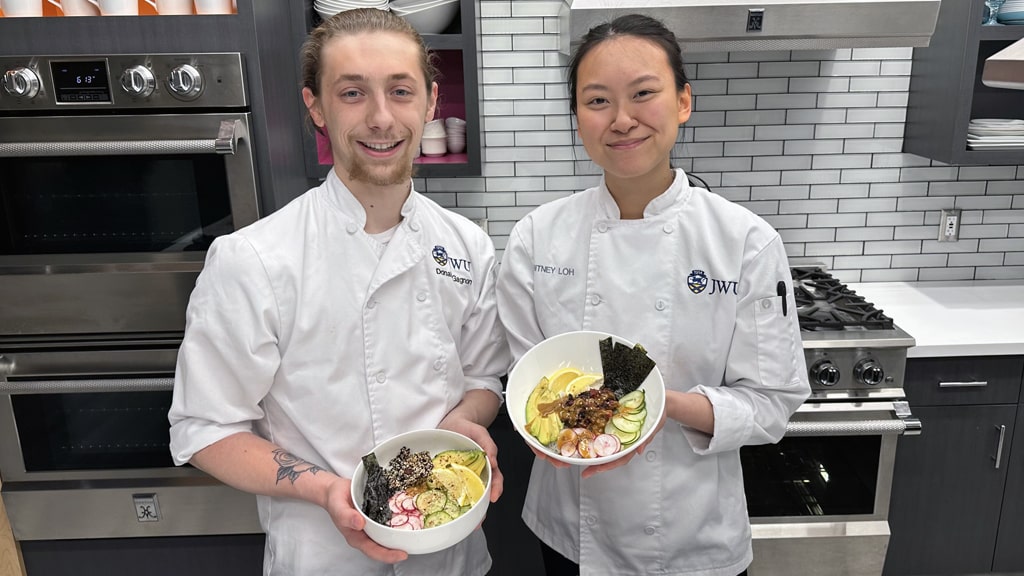Summer Recipe: Vegan “Tuna” Poké Bowl
Vegan alternatives to tuna have proliferated wildly in the past few years. Chickpeas, tomatoes, and the adaptable workhorse Textured Vegetable Protein (TVP, aka soy chunks) have all pitch-hit for the over-fished sushi favorite. In this recipe, watermelon takes a star turn as a tuna-facsimile — and the recipe is as simple as it is versatile and refreshing.
“It’s not a perfect tuna taste, but the color and texture make it a good replacement,” says Donald Gagnon '24, a Dietetics and Applied Nutrition major who will be leading us through the making of this dish with Britney Loh '24, a Culinary Science and Product Development major.
“You want to retain some moisture for texture, so don’t overcook this.”
To start with, be careful to choose a watermelon that is ripe (even a bit underripe), but not overripe or mealy. From there, you want to cut the watermelon into uniform rectangular planks that are roughly 3" x 2".
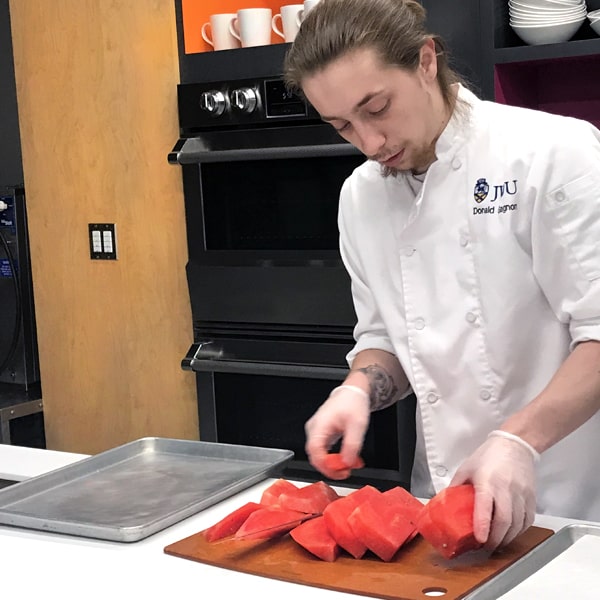 To do this, Gagnon lops off the top and bottom of the watermelon; this allows him to rest it vertically on his cutting surface. Holding the fruit steady with one hand, he slices off the rind in vertical strips, rotating clockwise as he goes. All of the exterior rind should be removed before moving on to the next step, which is cutting your planks.
To do this, Gagnon lops off the top and bottom of the watermelon; this allows him to rest it vertically on his cutting surface. Holding the fruit steady with one hand, he slices off the rind in vertical strips, rotating clockwise as he goes. All of the exterior rind should be removed before moving on to the next step, which is cutting your planks.
Now you should have a perfect dome of watermelon. Cut vertically through the watermelon at 1" intervals — this will give you broad slabs. Now rotate the entire melon 90° and cut vertically at 1" intervals again. Now you should have fairly even rectangular planks with some variation, depending on the curvature of the melon’s exterior.
Take the center planks that are the most even, and lay them out on a sheet pan that’s been lined with parchment. Sprinkle lightly with salt. Bake at 400° for one hour, flipping halfway through the cooking time. “You want to retain some moisture for texture,” notes Gagnon, “so don’t overcook this — otherwise you’ll get a fruit leather-like texture.” Take the “steaks” out of the oven and let them cool.
Now prepare your marinade: Whisk the sesame oil, soy sauce (or tamari, if you want to make this gluten-free), rice vinegar, grated garlic, ginger, and chili powder or togarashi together in a bowl.
Once the melon is fully cooled, cut it into even cubes and toss in the marinade. Add the chopped nori to the mixture, then toss to coat. Once the pieces are evenly coated, transfer them to a large freezer bag and place in the refrigerator to absorb all that flavor. The longer they marinate, the more flavor they will absorb so marinate up to 24 hours for a more intensely fish-like flavor.
Serve chilled, or you can coat the melon’s surface in sesame seeds and fry quickly in hot oil. (“You’re not cooking the watermelon so much as you’re toasting the sesame seeds,” notes Gagnon. “Alternatively, you could just toast the seeds and then toss the melon in them, which would impart that toasty flavor.”)
Serving Suggestions
🍉 Drain the marinade (save it and use it to season rice), then plate your marinated watermelon-tuna with thinly-sliced daikon radish and fresh wasabi. (It may not need extra soy sauce or tamari because it’s soaked up the marinade; always taste first, then add extra seasoning as needed.)
🍉 You can also create a flavor-packed, umami-rich rice bowl: Start with a base of cooked rice, then add your marinated watermelon-tuna. Top with your favorite rice bowl additions like thinly-sliced avocado, toasted nori sheets, sliced radish, cucumber and a lemon wedge.
🍉 An alternative dressing is a peanut satay sauce, which includes a tablespoon of peanut butter whisked into the reserved marinade and drizzled over the rice bowl. Top with toasted sesame seeds.
Watermelon “Tuna”
6 servings
INGREDIENTS
26 ounces (750g) watermelon, seeded & peeled
½ teaspoon salt
3 tablespoons sesame or peanut oil
2 tablespoons tamari or soy sauce
2 tablespoons rice vinegar
2‐3 garlic cloves, grated on a microplane
2 teaspoons ginger, grated on a microplane
½ teaspoons chili powder or shichimi togarashi
1 nori sheet, coarsely chopped
DIRECTIONS
1. Prep the watermelon by trimming the rind, then cutting the flesh into even cubes of roughly 1" x 1" or “steaks” of roughly 3" x 2". Make sure to cut the watermelon planks to a consistent thickness. (Keep in mind that the melon will lose liquid during cooking, and it will shrink somewhat.)
2. Lay the watermelon planks out on a parchment-linked sheet pan, leaving sufficient space in between each piece. Season them lightly with salt.
3. Bake at 400° for one hour, flipping halfway through the cooking time.
4. Let the planks cool completely.
5. As the watermelon cools, prepare your marinade by whisking soy sauce or tamari, sesame oil, grated garlic and ginger, chili powder, and rice vinegar.
6. Pour the marinade into a large freezer bag, then add the watermelon.
7. Seal the bag, then agitate it slowly to distribute the marinade evenly.
8. Place in the refrigerator for up to 24 hours.
Watch the making-of video below:
View this post on Instagram
RELATED READING
JWU Recipe: Springtime Lemon Curd
TOP: THE FINISHED RICE BOWL GARNISHED WITH TOASTED NORI AND A LEMON WEDGE. BELOW: WATERMELON PLANKS, READY TO BE BAKED. DONALD GAGNON (LEFT) AND BRITNEY LOH IN THE FOOD INNOVATION DESIGN LAB KITCHEN. BOTTOM: THE FINISHED BOWL.
